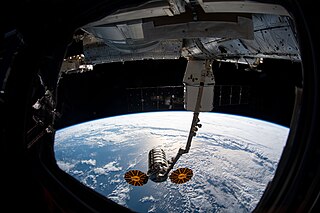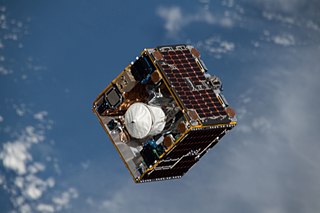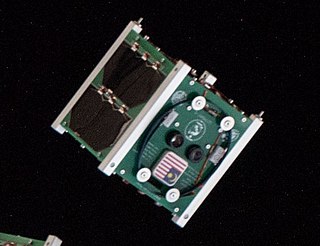RAIKO is a Japanese satellite which was built and operated by Tohoku and Wakayama Universities. A two-unit CubeSat, RAIKO was deployed from the International Space Station (ISS) on 4 October 2012, having been launched on 21 July 2012.
Surrey Satellite Technology Ltd, or SSTL, is a company involved in the manufacture and operation of small satellites. A spin-off company of the University of Surrey, it is presently wholly owned by Airbus Defence and Space.
Technology Education Satellite (TechEdSat) is a successful nano-sat flight series conducted from the NASA Ames Research Center in collaboration with numerous universities. While one of the principal aims has been to introduce young professionals and university students to the practical realm of developing space flight hardware, considerable innovations have been introduced. In addition, this evolving flight platform has tested concepts for Low Earth Orbit (LEO) sample return, as well as planetary nano-sat class mission concepts.

Nanoracks LLC is a private in-space services company which builds space hardware and in-space repurposing tools. The company also facilitates experiments and launches of CubeSats to Low Earth Orbit.

WE WISH was a small commercial CubeSat which was deployed from the International Space Station (ISS) in October 2012 and which deorbited in March 2013. It was built by the Japanese technology company Meisei Electric and the Meisei Amateur Radio Club, and could transmit pictures taken by a small infrared camera via radio at 437.515 MHz. WE WISH travelled to orbit aboard Kounotori 3 (HTV-3) on 21 July 2012, along with other CubeSats including RAIKO, FITSAT-1, F-1, and TechEdSat-1.

Planet Labs PBC is a publicly trading American Earth imaging company based in San Francisco, California. Their goal is to image the entirety of the Earth daily to monitor changes and pinpoint trends.

The Nanoracks CubeSat Deployer (NRCSD) is a device to deploy CubeSats into orbit from the International Space Station (ISS).

NG-11, previously known as OA-11, is the twelfth flight of the Northrop Grumman robotic resupply spacecraft Cygnus and its eleventh flight to the International Space Station under the Commercial Resupply Services (CRS-1) contract with NASA. The mission launched on 17 April 2019 at 20:46:07 UTC. This is the last mission from the extended CRS-1 contract; follow-up missions are part of the CRS-2 contract. Cygnus NG-11 was also the first mission to load critical hardware onto Cygnus within the last 24 hours prior to launch, a new Antares feature.

GhanaSat-1 was the first Ghanaian nanosatellite to be launched into space. It was designed and built in two years in conjunction with the Kyushu Institute of Technology Birds-1 program, which has the goal of helping countries build their first satellite.

BRAC Onnesha was the first nanosatellite built in Bangladesh to be launched into space. The satellite was designed and built in conjunction with Kyushu Institute of Technology Birds-1 program, which has the goal of helping countries build their first satellite. It was designed and built over a two-year period.

Birds-1 was the first iteration of a multinational program called the Joint Global Multi-Nations Birds Satellite project, or Birds project, to help countries build their first satellite. The Japanese Kyushu Institute of Technology (KIT) supported the design and fabrication of the satellites. The constellation was launched by a Falcon 9 rocket to the International Space Station on 3 June 2017, as part of CRS-11, where it was released from the Kibō module into space. Japan, Ghana, Mongolia, Nigeria, and Bangladesh participated in the Birds-1 program, all building identical satellites for the constellation.

RemoveDEBRIS was a satellite research project intending to demonstrate various space debris removal technologies. The mission was led by the Surrey Space Centre from the University of Surrey with the satellite's platform manufactured by Surrey Satellite Technology Ltd (SSTL). Partners on the project included Airbus, ArianeGroup, Swiss Center for Electronics and Microtechnology, Inria, Innovative Solutions In Space, Surrey Space Centre, and Stellenbosch University.
UBAKUSAT was a Turkish nanosatellite that was developed by Istanbul Technical University. It was launched into space on board a Falcon-9 rocket in April 2018 and was deployed into its orbit from the International Space Station in May 2018. It was built as a technology demonstration and Earth observation satellite to provide voice communications for amateur radio stations around the world. It carried an experimental card, TAMSAT Simplesat, which allowed scientists to test its accuracy of measuring radiation from space. It was the fifth satellite to be built by students of Istanbul Technical University.

BHUTAN-1 was the first Bhutanese nanosatellite to be launched into space. The satellite was built during Kyushu Institute of Technology's Birds-2 program. The Birds program helps countries fly their first satellite. BHUTAN-1 was launched into orbit aboard the SpaceX CRS-15 mission on 29 June 2018. It was deployed from the Kibō module of the International Space Station (ISS) on 10 August 2018. The satellite had cameras to image the Earth.

Birds-2 is the second iteration of a multinational program called the Joint Global Multi-Nations Birds Satellite project, or Birds project, to help countries build their first satellite. The Japanese Kyushu Institute of Technology (KIT) supported the design and fabrication of the satellites. The satellites were launched by the Falcon 9 Full Thrust rocket as a part of the SpaceX CRS-15 mission on 29 June 2018. The satellites were released from the Kibō module of the International Space Station (ISS) in August 2018.
The Innovative Satellite Technology Demonstration Program is a series of spacecraft missions for testing technology and ideas put forward by universities and private companies. The program demonstrates various experimental devices and technology in space by providing flight opportunities. It is managed by the JAXA Research and Development Directorate. According to JAXA, the goal of this program is to test high risk, innovative technology that will lead to the space industry gaining competitiveness in the international field.
Warpspace is a private Japanese company developing an inter-satellite communication system based on laser communication. Warpspace is developing a medium Earth orbit satellite, WarpHub InterSat, which will communicate with other satellites in low Earth orbit using optical communication, then pass on the received data to ground stations.

Equatorial Space Systems PTE LTD. also known as Equatorial Space, is a Singapore-based company that develops hybrid-engine rockets and space launch services. The company was founded by Simon Gwozdz and Praveen Ganapathi Perumal in 2017 in Singapore, with the goal to develop low-cost, safe and eco-friendly space launch vehicles.
TUMnanoSAT was a nanosatellite and the first artificial satellite made by Moldova. It was built by the Technical University of Moldova (UTM) and was launched on 15 July 2022. SpaceX's Falcon 9 rocket carried TUMnanoSAT to the International Space Station (ISS). This was through the SpaceX CRS-25 Commercial Resupply Service mission. In this mission, Falcon 9 carried a SpaceX Dragon 2 spacecraft which contained the J-SSOD launch capsule of the Japan Aerospace Exploration Agency (JAXA) within which in turn was TUMnanoSAT. The satellite project and its launch was carried out in cooperation with the JAXA and the United Nations Office for Outer Space Affairs (UNOOSA) as part of the KiboCUBE program. Once brought to the ISS, TUMnanoSAT was put into orbit from there on 12 August.












